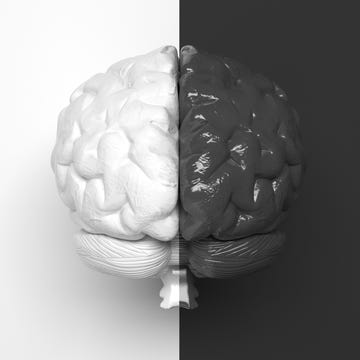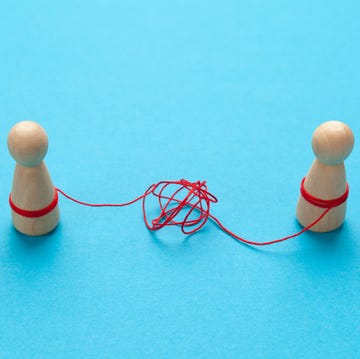The grocery store checkout line was wrapping around the produce section one Saturday morning, and the very pregnant woman behind me looked hot and exhausted, so I motioned her to go ahead of me. As we commiserated about the summer heat, my heart began racing and I could feel tiny sweat beads forming on my forehead, despite the store’s arctic AC. I smiled along, but my mind flashed back to the moment 17 years earlier when my doctor, barely taking the time to look me in the eye, callously sentenced me to five months of pregnancy-related bedrest. I had unusually large fibroids, and she warned me that my baby might not survive.
As this long-ago trauma washed over me like a tsunami, I made a mental list of all the things that could go wrong for the woman in front of me, who looked like she was smuggling a watermelon under her sweat-drenched shirt and could potentially give birth right there by the Tic Tac rack. By the time she began putting her items on the conveyor belt, I was so worried for her health and safety that I began feeling queasy. Logically, I knew that her experience would not be the same as mine, and my son had turned out just fine, but I felt like I was right back in my doctor’s office, hearing my own diagnosis all over again, paralyzed with fear. As I loaded up my car in the parking lot moments later, I had to hold back my tears. Why couldn’t I just feel joy for this woman? And why, after all these years, did I feel so helpless and terrified when I recalled my own difficult pregnancy? Why did it still have so much power over me?
It turns out that my meltdown at the grocery store was a sign of progress. Tracey Shors, PhD, a professor in behavioral and systems neuroscience at Rutgers University and author of Everyday Trauma, considers this kind of event a normal stress response. I wasn’t regressing into my past trauma, she told me; I was healing. Over time, she explains, “the brain learns that just because you were exposed to a memory, it doesn’t mean you have to be afraid.” This resonated. It wasn’t the first time the sight of a pregnant woman had triggered me, and it probably wouldn’t be the last. To avoid a panic spiral, I just had to remind myself I was safe in the moment. A very helpful tactic, says Olivia Remes, PhD, mental health researcher at the University of Cambridge and author of This Is How You Grow After Trauma, is pinpointing what your triggers are. “Knowledge is power,” she says. “The more we become aware of our patterns, the more we are in a position to change them.”
More From Oprah Daily

So how can you tell if you’re moving forward, even when it feels like you’re taking a million steps backward? Here are three self-defeating thoughts that actually show you’re healing:
Negative thought: I’m reliving a painful experience yet again. I must be stuck.
Healthy translation: I’m aware of my body’s stress response. I know it’s natural.
Sweat pours down your back, your jaw clenches, your muscles tense. This is a normal reaction when confronted with old wounds. Being aware of the brain-body connection and acknowledging that your racing heart and knotted stomach are just physical manifestations of a bad memory can dial down your anxiety and help the symptoms abate much more quickly. Shors suggests reminding yourself that “a memory is just molecules that have created an image, but the experience itself is gone.” Over time, your physical response to a painful memory will diminish as you remind your brain to stop being scared. Shors recommends a combination of aerobic exercise and meditation to feel less anxious and afraid. Exercise can produce feel-good endorphins, while meditation helps us slow down and become more aware of our thoughts and feelings.
Negative thought: I still have moments of fear and indecision. Yep, definitely stuck.
Healthy translation: I’m letting myself feel my feelings. That’s how I’ll heal.
Letting yourself feel your feelings instead of suppressing them is a sure sign of growth. “When you begin healing from trauma, you start to allow different complex feelings to emerge,” Remes says. Instead of running away from your emotions, and potentially turning to alcohol or substance abuse to numb or further suppress them, you allow yourself to move through them and emerge on the other side, hopefully freer from pain, fear, and indecision.
People have complicated, sometimes even contradicting emotions around their trauma. You may experience anger and sadness but also feel grateful that you survived the experience. Being able to acknowledge this without guilt or shame is the key to moving forward, even if it takes years. Reminding yourself that the trauma happened in the past and that you are safe in the present moment can help you identify negative thoughts, acknowledge them, and then stop them from spinning out of control.
Negative thought: I can’t stop talking about what happened to me. I’m stuck in a loop.
Healthy translation: I’m confiding in people I trust. I’m not hiding or suffering in silence.
It can make you feel incredibly exposed to share your deepest darkest secrets with others, but when you take a risk and make yourself vulnerable to people with whom you feel safe, two wonderful things happen: You release a huge amount of stress, and you create a sense of trust. “Shedding tears helps release oxytocin and feel-good chemicals. The moment you let other people see the real you, this puts you in a position to get better. It’s a sign that you’re opening yourself up to the real world and allowing other people in,” says Remes.
Crying in front of your friends, your therapist, and other people you trust is not only cathartic but also creates bonds and builds both a sense of community and a safety net. Maintaining strong connections has also been proven to help us navigate and, ultimately, move through difficult experiences. Next time you have a reaction to a past wound, don’t isolate yourself. Instead, call a friend, let them know you need support, and unleash the cascade of tears.
Traumatic events can be so devastating that it takes time for our brains to understand they are no longer harming us. Be kind and patient with yourself, and “accept the uncertainty you’re feeling,” Remes says. “Meet yourself where you are.”
Aileen Weintraub is a New York–based editor and journalist and the author of Knocked Down: A High-Risk Memoir. Her work has appeared in The Washington Post, Glamour, InStyle, and AARP. Find her on X @aileenweintraub.












